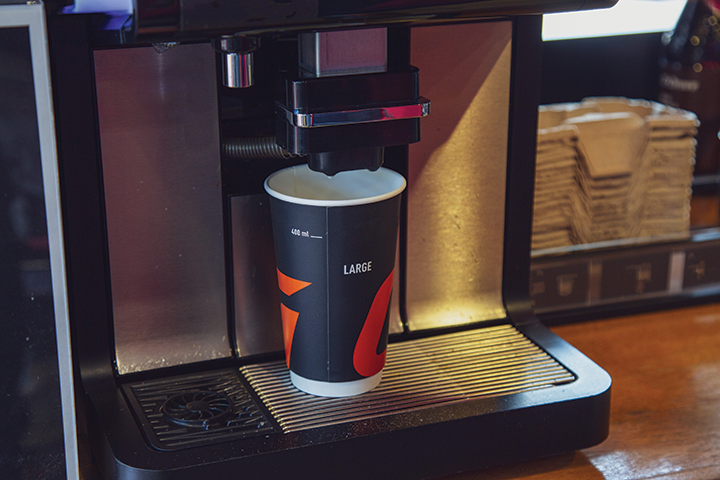Keeping Dispensing Equipment Clean
Understanding how NSF’s manual food and dispensing equipment standard supports safe materials, design and performance.


Food and beverage dispensers are often found in higher-traffic areas, where warm and moist air is conducive to the spread of germs. As such, food safety is paramount in dispensers. Customers want confidence that filling up their paper soda cups or squirting mustard onto their hot dogs won’t make them sick. That’s why many operators seek out equipment that is NSF/ANSI 18 certified, which must meet minimum food protection and sanitation standards for the materials, design, manufacture, construction, and performance of manual food and beverage dispensing equipment and their related components.
Understanding NSF/ANSI 18
NSF/ANSI 18 was first published in 1966 with a focus on requirements for manual food and beverage dispensing equipment such as beverage dispensers, bulk dispensers and components. The scope of the standard includes beverage dispensers, bulk dispensers, portion dispensers, and components of food and beverage dispensers such as valves. The NSF glossary of food equipment terminology defines “dispenser” as a unit for the storage and pre-portioned transfer of material such as beverages, condiments, food, soaps or wares. Some of the common products dispensed in NSF/ANSI 18 equipment includes condiments, syrups, sauces, soda, water, coffee, and tea.
The standard covers many of the most commonly found products in restaurants and convenience stores, however, it is critical to understand that not all types of dispensers are covered under the scope of NSF/ANSI 18. The standard does not include vending machines, dispensing freezers or bulk milk dispensing equipment. This equipment is covered by other NSF/ANSI standards listed below:
-
NSF/ANSI 6: Dispensing freezers
-
NSF/ANSI 20: Commercial bulk milk dispensing equipment
-
NSF/ANSI 25: Vending machines for food and beverage
Requirements Vary Based on the Dispenser Type
The requirements for the materials, design and performance can vary based on how the dispenser is intended to be used. Some questions to consider when sourcing a certified food or beverage dispenser:
-
What type of food or beverage is being dispensed?
-
Does the food or beverage require hot or cold holding storage for safety?
-
Where is the food or beverage stored in the dispenser?
-
How is it dispensing the food or beverage?
Each type of dispenser will have a different design to accommodate the product and method of dispensing for the user. For example, a condiment dispenser could include a refillable container and a pump that is pressed to dispense a portion. Another example is a soda dispenser, which uses bag-in-box (BIB) syrups and water or carbon dioxide connections to dispense carbonated beverages via an activated lever mechanism.
Temperature Control in Dispensers
NSF/ANSI 18 outlines specific requirements for dispensers used for foods that require temperature control for safety, also referred to as time/temperature control for safety foods. These dispensers must hold food or beverage products at properly defined temperatures — 41 degrees Fahrenheit (5 degrees Celsius) for cold food holding and 140 degrees Fahrenheit (60 degrees Celsius) for hot food holding — and undergo the standard’s cold or hot holding performance tests.
Temperature-indicating devices are required to display the temperature inside the storage compartment or product reservoir and be accurate to +/- 2 degrees Fahrenheit (1 degree Celsius). A storage compartment holds packaged products such as bag-in-box syrup, cartons or refillable containers, while a product reservoir is filled with the food or beverage poured from the original sealed package.
Ensuring Cleanability and Limiting Cross-Contamination
Dispensers that are designed with a fixed flow path not readily accessible for manual cleaning rely on clean in place (CIP) methods that expose the flow path to cleaning and sanitizing solutions. NSF/ANSI 18 requires written instructions for CIP procedures that ensure cleaning and sanitizing solutions contact all food contact surfaces. As part of the NSF certification process, a performance test is conducted to challenge the dispenser with an E. coli mixture followed by the CIP procedure to validate the effectiveness.
Another important consideration when choosing a dispenser is whether or not it will be used for customer self-service (versus employee-only use). Dispensers intended for customer self-service have dispensing mechanisms such as an activating lever that does not come in direct contact with the lip or upper portion of a cup or container. This helps to avoid contamination between the mechanism and germs on the lip of the cup.
Ice and Backflow
Many beverage dispensers dispense ice via an internal ice bin and may be designed to have an ice maker installed onto the dispenser. The ice bin can either be located above or below the unit and must include a cover that meets requirements to prevent contamination of the ice.
Regarding backflow, dispensers that have a water connection under pressure need to have adequate backflow prevention to protect the incoming water supply from contamination. A certified dispenser may be provided with a backflow preventer installed. Another option would be a statement on a label indicating the dispenser is to be installed with adequate backflow protection to comply with applicable federal, state and local codes.
Benefits of Using Certified Materials
NSF-certified materials or components used in dispensing equipment can reduce the overall amount of evaluation or testing necessary for the dispenser. These include NSF-certified materials, pumps, valves, fittings, and temperature-indicating devices. By using such materials or components, a manufacturer can save both time and cost.
NSF standards help both dealers and manufacturers of food equipment to prioritize food safety and human health. Many public health inspectors look to the NSF standards and NSF certification mark as symbols of verified food safety. Find NSF-certified materials, components and food equipment listed on the NSF website. For more information about NSF/ANSI 18, visit https://www.nsf.org/food-equipment.


